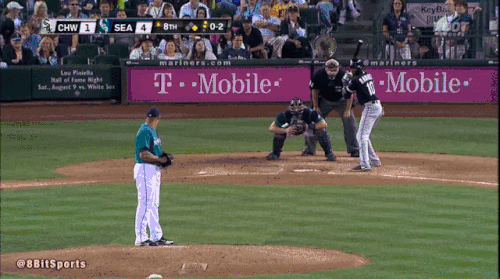Pitching Backwards
Although it admittedly sounds weird, pitching backwards is a rather common strategy for upsetting the timing of batters. Generally, and particularly at the lower levels of baseball, pitchers throw their fastball the majority of their time on the mound. Either they’re too young to throw the more difficult, strenuous pitches, or they have no confidence in their other abilities, so they’re forced to throw fastball after fastball. And even if you’ve got good velocity or control, batters will ultimately catch-up and learn to time their swings more appropriately.
In fact, having a good fastball almost guarantees nothing as you get older and an advanced control of the other pitches in your arsenal becomes more and more important. Keeping batters off-balance and guessing is much more important than just trying to blow one by the hitter. Pitching backwards is when a pitcher uses their secondary offerings rather than their fastball early on in the count. Traditionally, hitters expect fastballs early in the count and off-speed pitches late in the count, so reverse it on them! Take these CoachUp certified tips with you the next time you’re looking to switch it up on the mound.

Jack Of All Trades
Even hard throwers that throw major heat at hitters will need to offer pitches with speed differentials. Consecutive pitches of similar speeds are easier for hitters to time correctly. The same logic holds true for off-speed pitches – the more they see consecutively, the better they’ll react next time. A good rule of thumb for proper speed differences between pitches is 7 to 10 mph. Any speed under that is close enough to the previous pitch and easier to time.
Examples of good sequences include:
- Fastball, curveball, fastball, changeup, fastball
- Curveball, fastball, changeup, fastball
- Fastball, changeup, fastball, curveball
Locations and intensity of pitches are also variable giving many options when choosing pitch sequences for each hitter. Be advised, hitters will talk to their teammates. Expect your opponent to recognize the sequences you use most. The ability to adapt in-game, and in-between batters, is another trait of the highly successful pitcher. If you achieve the ability to variably mix up your speeds effectively, it will bring you one step closer to dominance.
Seeing Is Believing
Perceived Velocity is an advanced concept that can also help take a pitcher’s performance to the next level. The theory states that pitch locations nearest the hitter’s eyes are observed to be the highest velocity. Using this logic, a pitch far from the hitter’s eye is recorded as slower to the hitter. Imagine the potential for changing speeds with not only your fastball, but once you add in the others? Game over. Follow a high and inside fastball with a curveball low and outside, and you’ll have an absolutely brutal difference in Perceived Velocity. Thus, making solid contact with the pitch highly unlikely.
Upset the hitter’s timing by utilizing Perceived Velocity to your advantage. Keep in mind that pitches thrown to the same location over and over lack the velocity difference that’s crucial to throw the batter off-balance. Even if the pitcher has inadequate velocity to intimidate the hitter, fastballs must be used to establish the inside of the plate and complement the off-speed offerings.
(Related: Read about using the long toss to your advantage here.)
Huddle Up
Using this strategy will require absolute confidence in every pitch you have. True confidence is mainly sprung and built-up from a strong mental front, but mastering your pitches is a crucial component as well. To be an effective pitcher, you’ll have to be constantly evolving during the off-season, practices, and early mornings. But, perhaps even more importantly, you’ll have to be willing and able to reassess and change during the game. If a player has had success against your change-up in his first two at-bats, don’t throw it. If you’ve relied too much on your fastball, throw him something slower to mix it up.
Being a pitcher is a constant game of cat-and-mouse, learning when, where, and how to deliver the devastating, futile, and unhittable pitches that will win the game for your team. So, don’t be afraid to try something new, or to work on a pitch that hasn’t gone well before — establishing a wide-range of pitches and control is the key component to making a hitter look silly. And at the end of the day, isn’t that all a pitcher wants?
If you’re still having trouble, consider hiring one of CoachUp’s private trainers to help you get more command and movement on your pitches. Our expertly built team has years of experience and will have you confusing hitters and sitting them down in despair in no time — what are you waiting for?
How useful was this post?
Click on a star to rate it!
Average rating 5 / 5. Vote count: 4
No votes so far! Be the first to rate this post.




